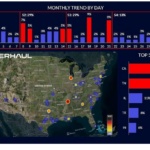AAA forecasts that 79.9 million people will travel 50 miles or more from home during the Thanksgiving holiday period, with the majority opting to hit the highways.
The organization reports a record-breaking 71.7 million travelers will journey by car this Thanksgiving, an increase of 1.3 million compared to last year. This year’s figure also exceeds pre-pandemic levels, surpassing the 70.6 million car travelers recorded in 2019.
Drivers can expect some relief at the pump this Thanksgiving season, as gas prices are lower than in 2023. Last Thanksgiving, the national average was $3.26 per gallon, but dropping oil prices this fall might bring the average below $3 for the first time since 2021. In parts of the country east of the Rockies, gas prices in over a dozen states are expected to range between $2.25 and $2.50 per gallon.
“Thanksgiving is the busiest holiday for travel, and this year we’re expecting to set new records across the board, from driving to flying and cruising,” said Stacey Barber, Vice President of AAA Travel. “Americans reconnect with family and friends over Thanksgiving, and travel is a big part of that. AAA continues to see travel demand soar post-pandemic with our members looking for new adventures and memorable vacations.”
For the first time, AAA’s travel forecast includes the Tuesday before and the Monday after Thanksgiving to provide a more accurate picture of holiday travel patterns. This year, nearly 80 million people are expected to travel, an increase of 1.7 million from last year and 2 million more than in 2019.
Transportation analytics company INRIX advises that the busiest travel times on the road will be Tuesday and Wednesday afternoons. To avoid heavy traffic, the best time to drive is on Thanksgiving Day, when highways are typically less crowded. For those returning home, Sunday travelers should aim to leave early in the morning, while Monday drivers should anticipate a mix of holiday travelers and regular workday commuters.
“With a record number of travelers expected to be on the road, drivers should follow traffic apps and local news alerts to avoid major delays,” said Bob Pishue, transportation analyst at INRIX. “This is especially important for drivers in metropolitan areas like Boston, New York, LA, Seattle, and Washington, DC, where traffic is expected to be more than double what it typically is on a normal day.”
This year, the Thanksgiving travel period is defined as the seven days from Tuesday, November 26, to Monday, December 2. For the first time, AAA has expanded its forecast to include the Tuesday before Thanksgiving and the Monday after. Previously, the analysis focused only on the Wednesday through Sunday timeframe.





